Austin Maestro diesel mailvan reborn
Posted by Chris Graham on 8th March 2020
Although this unique, Austin Maestro diesel mailvan has been in preservation since 1991, it’s certainly not had the easiest of post-working lives, as Peter Simpson explains.
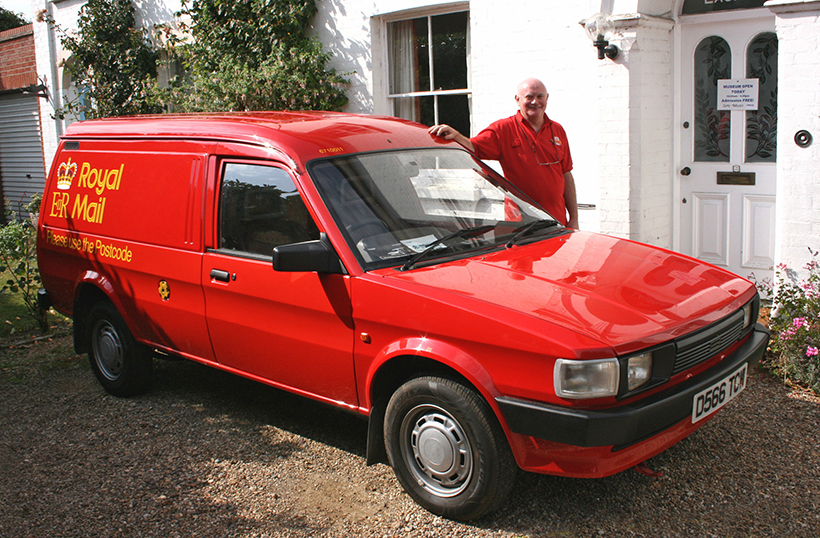
The Colne Valley Postal Museum’s 1987 Austin Maestro diesel mailvan after its third restoration, with owner/curator Stephen Knight.
One of the ‘star exhibits’ of Stephen Knight’s privately-owned Colne Valley Postal History Museum, is a rather special, 1987 ex-Royal Mail diesel Maestro van. Though ‘Red Robbo’, as the van is now affectionately known, was set aside for preservation from the moment it left frontline Post Office service in 1991, its existence since then has, to put it mildly, been somewhat precarious.
Though British Telecom made widespread use of Maestro vans, Royal Mail was less impressed. Just 384 Maestros of all kinds saw Post Office service, and the majority of those were either Postal Engineering vans, vans with rear seats and windows added for use as Postbuses, or hatchback staff cars. Just three batches of mailvans were supplied. The first came shortly after production started in 1984, the second in early 1987, and the third and final batch, in 1989. The 1987 batch of 70 Maestros were all diesel-powered, the Post Office having – in around 1985 – decided on an all-diesel policy.
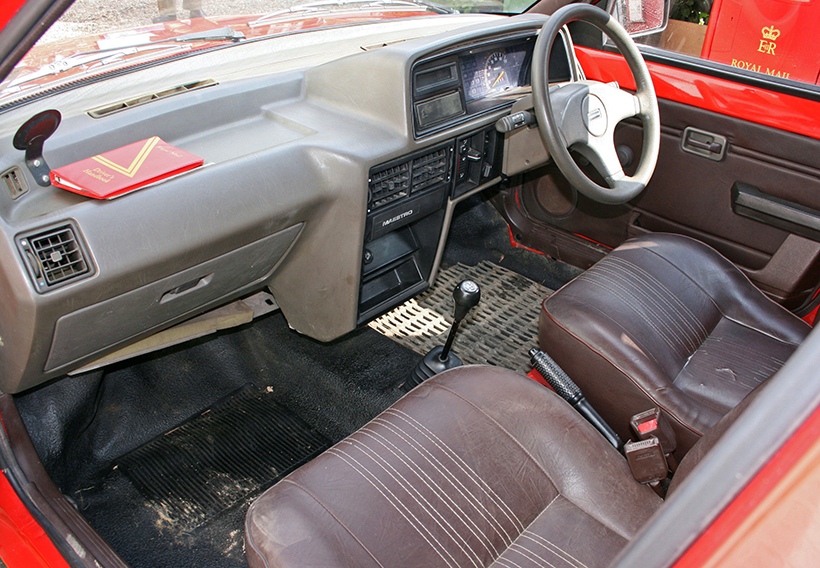
Front interior remains in substantially original condition – in part this is due to scarcity of replacement, low-spec trim in decent condition. Note the classic Post Office driver’s footwell mat!
The trial appears not to have been a massive success – the internal noise level was, apparently, a major issue, together with some concerns about reliability. The diesel Ford Escort, it was felt, met Post Office needs better, and it became the van of choice until the model left production in 2001-2. However, there was a brief interruption in 1992 when, for one year after problems became apparent with the ‘new’ MkV Escort diesel, the Post Office switched to Vauxhall Astramaxes. To put that figure of 384 Maestros into perspective, in 1985 alone (the first year of 100% diesel purchases), the Post Office bought 2,904 diesel Escorts, and 600 diesel Fiestas!
Powered by Perkins
The diesel Maestro van arrived in September 1986, as an option on both the 500 and 700 versions. This was, in fact, the first application of the new MDI engine; a diesel version development of the BL O series engine by Perkins – then, as now, one of Britain’s best-known diesel engine manufacturers. The MDI is actually better-known as the Perkins ‘Prima’ engine, even though this name was official only on engines actually sold by Perkins for marine or industrial applications.

Direct-injection diesel engine designed and built by Perkins.
The engines were designed and built by Perkins, although raw castings such as the main engine block, crankshaft and cylinder head, were made in the foundry at Longbridge, then transported to the Perkins factory in Peterborough for completion and assembly. Despite the design similarities, very few internal components were shared between the petrol and diesel engines.
Besides Maestro vans, the MDI/Prima was also used in the LDV 200 van from November 1986, replacing the 1.8 B Series diesel. It also went into the Maestro hatchbacks from 1990 while, from 1988, the Montego saloons and estate cars were available with a turbocharged version which gave a useful power boost from 60 to 81hp. The final Maestro cars also had this engine.
Unusually at the time, the MDI/Prima was a direct injection diesel, in which the fuel is injected directly into the cylinder, rather than into a separate, pre-combustion chamber adjacent to it; other manufacturers were choosing the latter because, despite being slightly less efficient (and thus less economical), engine noise levels were reduced considerably.
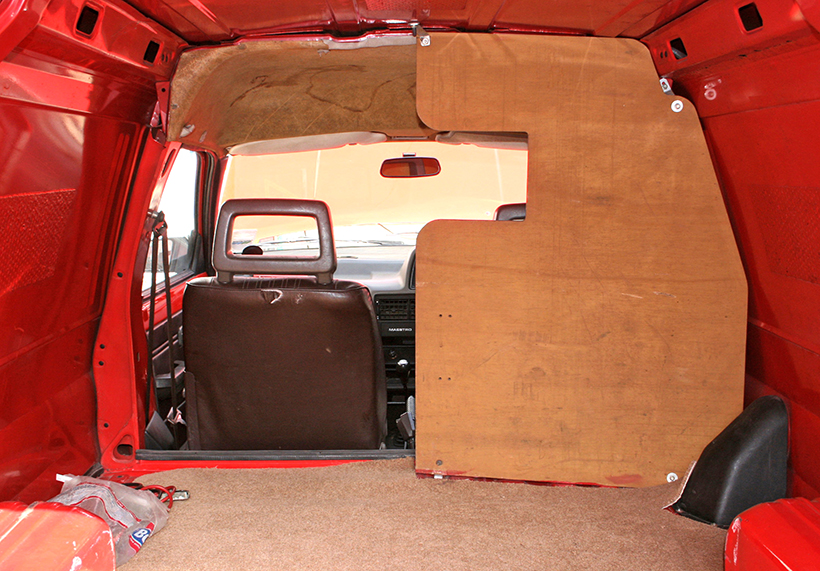
Loadspace, complete with original half-bulkhead to retain loads but also provide easy access. Interior noise was, apparently, one of the main reasons why Royal Mail never really took to the Maestro – despite anti-drum deadening on the side panels.
This gave the Maestro/Montego a worthwhile economy advantage over its rivals, albeit from a diesel engine which, basically, sounded like a diesel! Performance-wise, while 60hp wasn’t marvellous, it was considered more than adequate for a van, especially when combined with a torque curve that started to peak just a few hundred rpm above idle speed.
But it was the economy that was its best point – high 50s average, and over 60mpg possible on a run, without trying too hard. Servicing requirements were equally frugal – an oil service every year/12,000 miles, and a timing belt needed only at eight years/72,000 miles. All this, coupled to the fact that Austin-Rover (wisely) made no secret of the Perkins connection, must have made the Maestro van – on paper, at least – an extremely attractive proposition to buyers. Who, don’t forget, were often not the drivers…
One of the first?
Red Robbo was first registered on March 1st, 1987 – so, given that diesel production had started only the previous September, it could well be not just the only Maestro Mailvan left, but also the oldest surviving diesel Maestro of any kind – the diesel wasn’t offered in the cars until 1990, remember. It had serial (PO fleet number) 6710011 and spent its operational life in the North West. ‘CW’ is a Preston registration, and the van was new to the District Head Postmaster at Preston, and based first at Whalley. It later moved to Clitheroe, from where it was withdrawn in May 1991.

The driving position was pretty good, although unassisted steering was heavy.
Upon withdrawal, it was selected for official preservation as part of the National Postal Museum heritage fleet, and fully restored in Lancashire at either the Bamber Bridge Central Repair Depot, or its Post Office Transport Engineering Centre ‘POTEC’ successor. How much work was needed isn’t clear as the van, at that point, was only four years old, although that was four years of work as a mailvan…
Following closure of the Post Office central depots, the various historic vehicles were moved around and, at one point, kept in a former RAF hanger at Quedgeley, next to the M5, in Gloucestershire. Subsequently, several vehicles from the heritage fleet were declared ‘surplus to requirements’, and were offered first to other museums and, if there were no takers, then made available to individual enthusiasts via the Post Office Vehicle Club. D566TCW/6710011 was one of those.
Unfortunately, however, while wating for new homes, the vehicles for disposal were stored, in the open, at the old Wolverhampton postal workshop at Union Mill Street, Horseley Fields and, while what happened to D566 TCW in this time isn’t known, it did spend some time there, and some of the vehicles that did the same deteriorated badly.
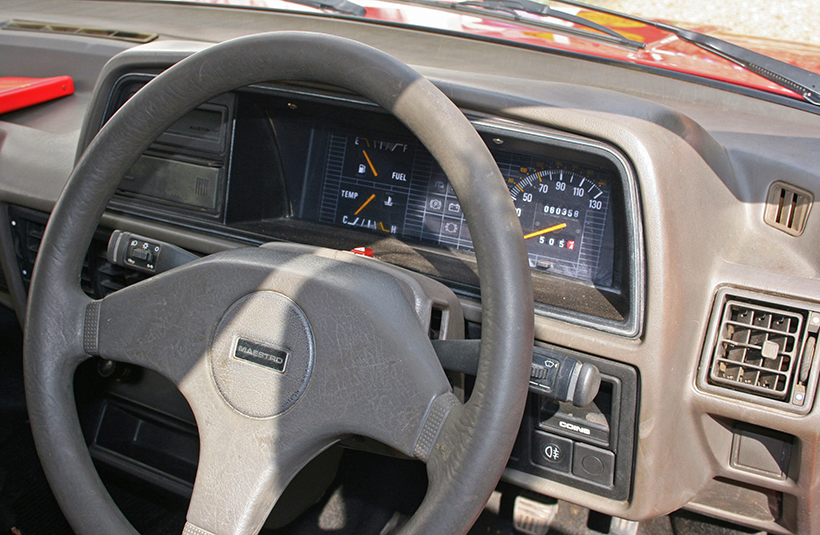
The instrument panel, as most who drove these will surely recall, tended to ‘shake and rattle’ a bit…
Perhaps unsurprisingly, there were no museum takers for a 1987 Maestro in the mid-late 1990s. In 1999, however, it found a new home in Shropshire, with a chap who was a Post Office Vehicle Club member at the time. He initially rallied it for a few years (without Royal Mail livery) in the Midlands and North West, before retiring it on to his driveway while several of his other vehicle restoration projects took precedence.
His wife was, shall we say, not understanding and, following their divorce, the van remained in the open on the driveway for about five years before, finally, being put undercover for the following 12 years, in long-term storage. It was then bought by its present owner, Stephen Knight, in May, 2017.
As mentioned at the start, Stephen owns and curates the Colne Valley Postal History Museum in North Essex; a rather special collection of post office memorabilia which is open to the public on a few days each year, or by special arrangement. He was keen to add a van to the collection and, on acquiring D566 TCW, he arranged a restoration.
The second restoration
Unsurprisingly, given that the van had probably been unused since the mid-1990s, much of the work needed was mechanical. The brakes were thoroughly overhauled, with new discs, pads and one rear wheel cylinder being fitted. The engine was given a full service and the cambelt was changed. A new rear light cluster (the same, apparently as on early Land-Rover Discoveries) came from Rimmer Brothers, while an old-school breakers yard in Mostyn, Clwyd, supplied a replacement headlight/indicator unit and, from a Maestro Hatchback, a spare wheel support cage was adapted to suit the van. Several fuel and brake lines were also renewed.

Rear doors, complete with period, 1980s Royal Mail lettering.
Bodywork-wise, a certain amount of localised tidying-up was required, followed by a full repaint; work which was carried out by Total Respray of Martock, in Somerset, under the direction of the current owner’s brother-in-law, Mark Cannon, at Compton Dundon Garage, who carried out the rest of the work. The period 1980s ‘graphics’ were made by St Ives (Cambridgeshire)-based Cameo Studios, using files created by Cream Link Design Studio, from cracked original, varnish-fit decals loaned by David Cott. Finally, the driver’s side sunvisor was replaced with one from a scrap Maestro, and an original BL jack (still boxed) was placed behind the driver’s seat.
The finished van was then displayed, on the Post Office Vehicle Club stand, at the 2018 Classic Van Show held at the British Motor Museum. Two days later, though, disaster struck. The van was at a local garage for a minor fuel/air leak that had developed on the drive to Gaydon, and was now causing starting difficulties, when it was stolen. It was subsequently used in a ram-raid involving the theft of a cash machine from the local Co-op. Fortunately, the Maestro wasn’t actually driven into the building; its role was to transport the ATM away from the theft, and into a nearby field, where the load was transferred to another vehicle. Nevertheless, it suffered significant damage to the lower panels (especially at the front and back) plus, due to the forced entry and drive-away, damage to the door and steering column locks, and the rear door interior hinges.
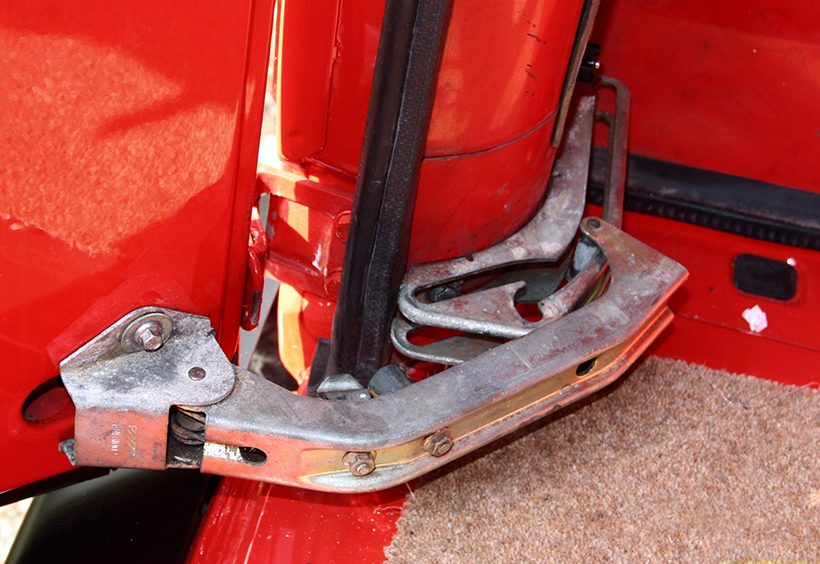
The rear door hinges were ungraded for Royal Mail use.
The third restoration!
So, a third restoration was needed. This time, however, while there was damage to contend with, a further major issue was sourcing some of the parts needed; in particular a correct, early van-type front bumper. To provide all this, a scrap 1989 ex-Telecom Maestro van was bought and stripped. This time the work was completed closer to home, with the bodywork being done by FLA of Halstead, with Alistair Smith ‘supervising’ the mechanical work. Alistair’s dad is a qualified Austin Rover technician, with access to all the original factory workshop manuals, a diesel timing gauge and the engine-specific crankshaft locking pins. The latter were especially important, as the starting issues had been traced to a problem with the diesel injector pump.
This is a crucial and complex component on old-school, pre-common-rail diesels, because it has to pressurise the fuel, and distribute it to each cylinder at precisely the right time for combustion to take place as the piston passes top dead centre. Overhauling one is definitely a job for a specialist but, just as importantly, the pump’s timing on reinstallation, has to be spot-on. Anyway, Alistair removed the injector pump and the separate fuel lift pump, which draws fuel forward from the tank and lifts it to the injector; much the same as a petrol engine’s fuel pump.
The injector pump was rebuilt in Warwick, by Bob Beck Diesels (highly recommended). Colchester Classic Spares came up with a new-old-stock lift pump.

Cambelt appears to have been changed by the Post Office at 41,000 miles – probably at eight years old, and during the officially preserved period as the official change interval is eight years/72,000 miles.
Fortunately, the donor van, coupled with ‘appeals’ through the classic car press, supplied all the replacement parts required. The rear door hinges were, it seems, a weakness on early vans, and had been upgraded by the time the donor was made, so the van currently has a stronger spring on the offside than the nearside.
Stephen also took advantage of the availability of a donor vehicle to have the dashboard swapped, as the original had the usual cracked top due to ultra-violet exposure over the years. The replacement was identical, apart from having a 12V socket/cigarette lighter into which Stephen can plug his satnav. FLA carried out a ‘partial respray’ of the damaged/repaired areas (Stephen says you “can’t tell where it starts and stops”), while replacement graphics were again made by Cameo Studios. A small amount of additional mechanical work was needed, including new wheel bearings and a brake master cylinder rebuild; new ones are unobtainable, but Rimmer Brothers could supply an overhaul kit.
Still to do
A couple of jobs remain to be done this year. The main one is fitting a new engine sump, the original having been dented by, it appears, driving over a fence stump after the ram-raid. Rimmers have supplied a sump seal/gasket (its last one, apparently…), and Stephen will be swapping the sump from the donor vehicle, although that’s “not urgent, and is a messy job!” He also plans to ‘match’ the rear door hinges, and the interior light needs sorting out.
So, there we have it; a unique van which is now with a passionate collector and, most importantly of all, a seemingly secure future. As well as being displayed at museum open days, it will be out and about at various events in East Anglia and further afield. Definitely one to look out for.
With thanks…
Stephen Knight would like to thank everyone involved in the restoration of this vehicle for their help. As well as those specifically name-checked already, he acknowledges the support of local enthusiast (and Scammell Highwayman owner) Adrian Cowlin, who not only provides storage but also helps out with “grunts, work, tools, tea and sympathy.”
Classic Van wishes to acknowledge the help with this article of Stephen Knight, and the Post Office Vehicle Club – specifically archivist Mark Skillen and magazine editor Chris Hogan, for providing the background information.
The Post Office Vehicle Club caters for anyone interested in Post Office and British Telecom vehicles, and includes an extremely active preservation section. For more details go to povehclub.org.uk or, for membership enquiries, email secretary, Frank Weston, at: povcmembership@btinternet.com or write to him, enclosing an SAE, at: 11 Acorn Road, North Walsham, Norfolk NR28 0UA.
The Colne Valley Postal History Museum is at 109 Head Street, Halstead, Essex CO9 2AZ, and contains a wide range of postal memorabilia, including 135 letterboxes, 25 stamp vending machines and a massive quantity of smaller exhibits plus, now, a unique Maestro mailvan! It’s also home to the National AA village signs collection.
Two public open days are held each year – the 2020 dates are May 17th and September 12th. There’s no general ‘walk in’ public admission at any other times, however, the museum can – subject to staff availability – be viewed by prior appointment; call 01787 474412 or email: kitmasterbloke@gmail.com
To subscribe to Classic Van & Pick-Up magazine, click here





